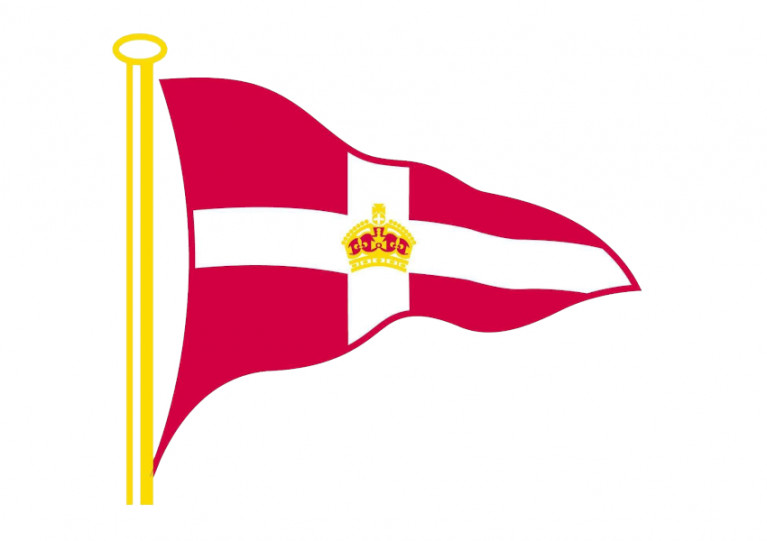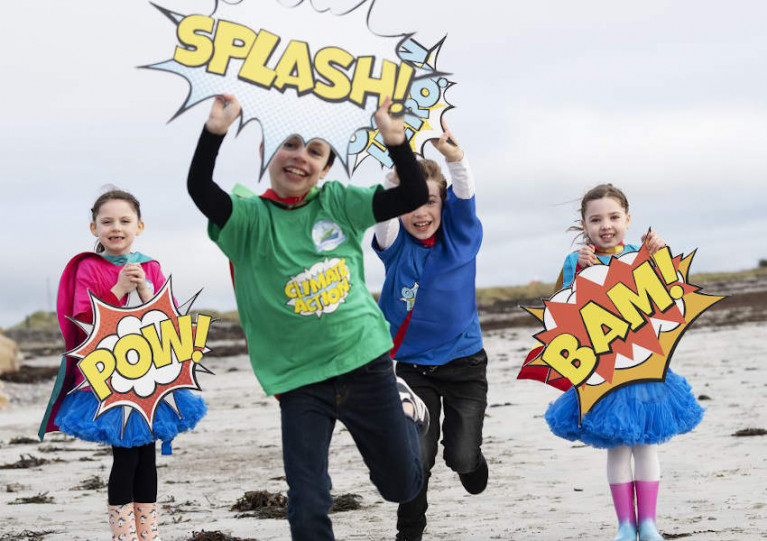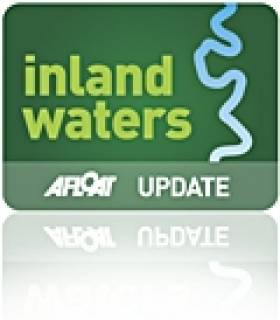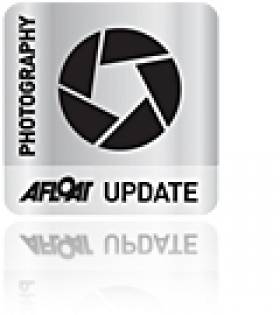Displaying items by tag: Competition
Celebrate St George’s Day At Home With The Royal St George
Due to the current Covid-19 restrictions in Ireland, the Royal St George Yacht Club will have a delayed — and decentralised —celebration of St George’s Day tomorrow, Friday 24 April.
All local members are invited join in from home with freshly made meals from the George in Dun Laoghaire to celebrate this important day for the club.
Members are also invited to send in a video or image featuring an interesting caption and your chosen freshly made meal to the RSGYC Facebook and Twitter pages using the hashtag #StGeorgesDayAtHome on your post.
Entries can be submitted up until next Monday 27 April, with winners announced at 5pm that evening.
Prizes include a freshly made meals voucher for four people, an RSGYC sailing jacket, an RSGYC polo shirt, and hand selected bottles of red and white wine.
Primary school children across Ireland are being invited to use the power of their imagination to save the ocean from climate change in a new art and writing competition.
The Explorers Pop Art & Creative Writing Competition was launched earlier this week by the Marine Institute’s Explorers Education Programme.
“By bringing science, art and creative writing together, the aim of the ‘ocean superhero’ competition is to cultivate the children's imagination, creating new ideas and solutions when addressing issues of environmental care and climate change,” said Cushla Dromgool-Regan, Explorers Education manager from Camden Education Trust who is co-ordinating the contest.
“The idea of creating an ocean superhero aims to help create a sense of hope for children at a time of adversity in the world, when the impacts of climate change can seem extremely challenging.”
The winners will see their art work and stories showcased as part of the Marine Institute exhibit at SeaFest, Ireland’s largest maritime festival, from 14-17 May.
A shortlist of VIP winning classes will be invited to visit the Marine Institute’s research vessel and its exhibition at Seafest, where they will get to meet world-leading speakers and scientists who are all working towards Ireland’s challenge in responding and adapting to climate change.
The Explorers Education Programme website has more information about the competition, including details of how to enter.
Photo Contest To Celebrate ‘Year Of The Salmon’ In Foyle & Carlingford Catchments
The Loughs Agency has announced a photography competition to celebrate the Foyle and Carlingford catchments and International Year of the Salmon.
Prizes of vouchers for an online camera shop are up for grabs — in categories for under and over 18s — for photographs that should depict one of the following themes:
- The Atlantic Salmon in celebration of International Year of the Salmon.
- Landscapes and seascapes that have as their subject the river or marine environments within Foyle and Carlingford catchments.
- Wildlife of Foyle and Carlingford that have the river or marine environment as their natural habitat.
The deadline for entries is noon on Friday 31 January. Full details of the categories, prizes and rules are available HERE.
Competition Launched to Name Biggest New Irish Sea Cruiseferry
#Competition - A competition has been launched by Irish Ferries to name their new €144m cruiseferry, which will be the biggest ever ferry to operate on the Irish Sea.
The 55,000 tonne ship is due to enter service in mid-2018. The winner of the naming competition will get free travel for life on Irish Ferries’ services, while 20 more will get runner-up prizes.
Capable of handling 1,885 passengers and crew and 500 vehicles, the new giant cruiseferry currently under construction in Germany for owners ICG (see related report) is expected to begin services next summer on the Dublin to Holyhead route.
In addition the new cruiseferry with 440 cabins featuring suites with their own private balconies will also at weekends sail between Ireland and France.
The ferry operator said a literary name is suggested for competition entries as the current fleet has traditionally had names inspired by Irish literature, including Oscar Wilde, Jonathan Swift and Ulysses. This cruiseferry introduced in 2001, is so far the biggest on the Irish Sea until the new maritime giant makes her debut next year during the holiday season.
Passenger facilities will include bars and lounge space, restaurants, cinemas, and a shopping mall. Freight drivers will have dedicated facilities and likewise for pet owners.
On the vehicle decks there will be space for almost three kilometres in lanes of car deck space.
Finalists Announced In Film Competition For Junior Anglers
#Angling - Four fishing clubs have been announced as finalists in Inland Fisheries Ireland’s Fish & Film Competition.
Junior members of Ballyshannon and District Angling Association in Co Donegal, Newport Sea Angling Club in Co Mayo, Whitelake Angling Club in Co Westmeath and the Sphere 17 Youthgroup in Darndale, North Dublin submitted entries which are being showcased online.
These clubs will now progress to the next stage of the competition, launched in June to encourage young people to spread the word about fishing.
Ballyshannon and District Angling Association’s film entry focused on a junior fishing day held at Lough Unshin, while Whitelake Angling Club’s submission shows young angling enthusiasts enjoying a quiet day’s fishing and presenting the viewer with their skills.
Newport Sea Angling Club’s entry highlighted the club’s recent National Junior Competition and Daniel Peacock Memorial event held in July, with all the excitement of a real competition day, while Sphere 17’s film take viewers on a sea angling trip off the East Coast.
The clubs are now appealing to the public to watch and share their film entries. The finalists will go forward to a junior fishing competition where they will compete against other entrants to be in with a chance of winning the top prize of €1,000 fishing tackle voucher for their club, or one of the €250 runner-up prizes which are also up for grabs.
“It is fantastic to hear from the next generation of anglers to find out more about what drives them to keep up fishing,” said IFI’s head of business development Suzanne Campion. “These entries really give a taste of what fishing is all about for junior anglers - I would like to commend them on their fantastic entries and wish them the best of luck at the next stage of the competition which sees them enjoying a free day’s fishing.”
The Fish & Film competition supports the objectives of Inland Fisheries Ireland’s National Strategy for Angling Development, which aims to make angling accessible and attractive to all while establishing it as a key leisure pursuit.
There are currently 273,000 domestic anglers in Ireland, and IFI aims to grow participation rates by 0.5% annually.
Visit the IFI website for more information on the competition.
#Angling - Junior fishing clubs, youth clubs, projects and centres are invited to take part in a new competition by filming their angling adventures and spread the word about fishing online.
The Fish & Film Competition launched by Inland Fisheries Ireland (IFI) will see entrants film a fishing trip and include fun interviews on what angling means to them.
The films will be youth-led in content and production, with all junior anglers up to and including the age of 18 eligible to apply.
All films submitted to IFI will also be uploaded onto its YouTube channel and the public’s views on each film will count as votes.
The top three groups who reel in the most views on their film will go forward to a junior fishing competition which includes a free day’s fishing for all.
The overall winner of the Fish & Film contest will receive a €1,000 fishing tackle voucher for their club, with the two runners up winning a €250 voucher.
“We want to hear from the next generation of anglers to find out what fishing really means to them – why they enjoy it and why they think other young people should get involved,” says Suzanne Campion, IFI’s head of business development.
“If we are to increase domestic participation and secure the long term future of angling, then we need to engage with the next generation of anglers and learn more about their experience of angling in Ireland.
“We also hope they will help us encourage other young people to discover angling as a hobby and help them realise that it is a pursuit that can be enjoyed at any age or ability.”
The Fish & Film competition supports the objectives of IFI’s National Strategy for Angling Development, which aims to make angling accessible and attractive to all while establishing it as a key leisure pursuit.
There are currently 273,000 domestic anglers in Ireland, and IFI aims to grow participation rates by 0.5% annually.
The closing date for applications to Fish & Film is Friday 14 July. Click HERE for more information on the competition and to download the competition guidelines and application form.
Winners Announced In Waterways Ireland Heritage Plan Art & Photographic Competition
#InlandWaters - Paul Moore from Tullamore took home the Over 18s award in the Waterways Ireland Heritage Plan Art and Photographic Competition for his breathtaking picture of Bolands Lock house on the Grand Canal taken on a frosty winter morning.
Moore's photo was chosen earlier this month after reviewing a very strong group of entries, from which Under 18 award winner Christoph Wagner from Cologne was also selected for his picture of Clonmacnoise from the River Shannon.
Both winners received an iPad Air tablet. To view their winning photos, visit the Facebook gallery HERE.
#InlandWaters - Waterways Ireland is seeking contributions from the public on what they think best fulfils the theme 'Waterways Heritage'.
Participants of all ages are invited to enter the Heritage Art/Photographic Competition to be in with a chance to win an iPad Air.
Heritage of the inland waterways can include monuments, archaeological objects, heritage objects, architectural heritage, flora, fauna, wildlife habitats, landscapes and geology.
Entries should be of the waterways under the jurisdiction of Waterways Ireland, which include the Shannon Navigation, Erne System and Shannon-Erne Waterway; the Lower Bann Navigation; the Barrow Navigation; the Royal and Grand Canals; and the Ulster Canal (Upper Lough Erne to Clones).
The judges will select an entry (photograph, painting, sculpture, etc) which best captures the heritage of the inland waterways.
Entries will be divided into two categories: 18 years and over and under 18s. A prize of an iPad Air tablet will be awarded to the winner of each category.
Take the summer to prepare your entry and submit before the closing date for the competition, 30 September 2015. Terms and Conditions apply and details are included in the entry form HERE.
For further information and competition rules contact Sabine Browne of Waterways Ireland at 061 922 141 or [email protected]
RORC Launches Photo Contest For IRC Yearbook Front Cover
#RORC - The Royal Ocean Racing Club (RORC) Rating Office is launching an international competition next week to select the photograph that will grace the front cover of the 2014 edition of the RORC IRC Yearbook, published by Yachting World.
Entry to the 2014 Yearbook Competition, which kicks off on 15 July, is restricted to two submissions per person to be submitted by 30 August 2013.
A shortlist selected from all the entries will then be judged by Yachting World's racing and technical editor Matthew Sheahan, RORC's technical director Mike Urwin, award-winning photographer Ian Roman and marine leisure PR consultant Peta Stuart-Hunt.
The judges will be looking for an exciting image that reflects the club racing ethos of IRC rating. This may be round-the-mark action from one of your local club weekend races, a fleet shot from a weekday 'twilight' race, or perhaps a lucky catch from one of the offshore classics.
They will not be looking for the 'glamour shot' of a exotic, high-tech racing boat so much as something that encompasses everything IRC stands for - competitive racing for all.
The winner will be notified by 30 September 2013 and will receive a certificate, and have their photo featured on the cover of the 2014 RORC IRC Yearbook, with appropriate credit as agreed with the winner. There is no monetary prize.
The competition rules are available on the RORC Rating Office website HERE.
Corrib Anglers Donate to Rescue Boat
#ANGLING - Days after the tragic death of an angler on Lough Corrib, as previously reported on Afloat.ie, the Collinamuck Angling Club will donate €5 from every entry in the upcoming open wet fly competition on 22 April to the Corrib Mask rescue boat.
"The important work that is carried out by the volunteers of the Corrib Mask rescue boat is sometimes forgotted by us anglers," the club's Lionel Flanagan told the Galway Advertiser at the launch of this year's contest.
"We hope this small token will help the Corrib Mask rescue boat continue to provide this vital resource to Connacht anglers and visitors alike.”





































































